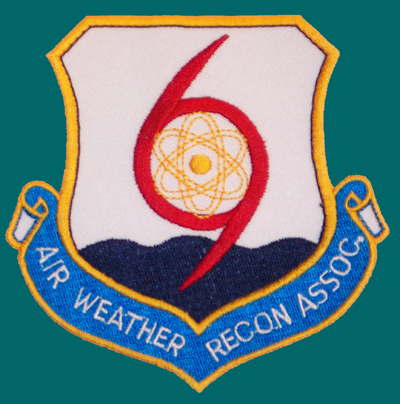
Colonel Paul H. Fackler
1915 - 1986
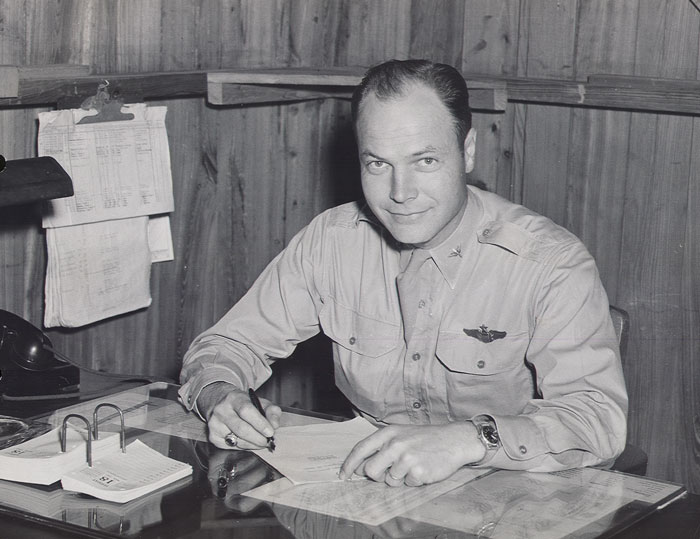 |
| Official
USAF Photograph, courtesy of the Air Force Weather History Office |
A true pioneer of weather reconnaissance, Paul H. Fackler commanded three squadrons and is credited with the first penetration of a nuclear cloud by manned aircraft. He authored a proposal for a special air sampling unit to support scientific aims of US domestic nuclear testing program. He was the only USAF officer to hold key positions in every nuclear test from 1946-56. |
| During the past
three years of doing research on early weather reconnaissance units and
missions, many names keep reappearing - Nicholas Chavasse, Thomas
Moorman, Richard E. Ellsworth, Robert G. David, and Karl Rauk to name a
few.
When you look at the squadron missions you find many others, like Earl
Dunphy, Roy
Ladd, Frank Bagley, Alvin Dill, Shirley Shaw, Paul Crumley, and
more. One other name appears time and again on both individual missions and as a leader of units. That person is Paul Fackler. I've had the chance to visit with several people who personally knew Col Fackler and flew with him. I have also spoken with his two sons. I'll share some of what I have learned so far. I would love to hear from anyone else who can add to my knowledge of Paul Fackler. If you have any questions or comments, write to the web master at: awra038@aol.com
The Early Years Paul
Fackler was born in Tolono, IL on 6 April 1915. He
graduated from the University of Illinois in 1938 with a B.S.
degree. In February 1939, he entered the Army Air Corps at
Chanute Field, IL.
He soon demonstrated excellent piloting skill and was assigned to Training Command. It was common in the WWII era to keep some of the best pilots on as instructors. When the new B-26 gained a reputation as a "widow maker" because of numerous accidents, Paul Fackler was one of a handful of pilots chosen to help fix the problem. They evaluated the situation and determined that they needed to extensively train new crews on how to handle single engine operation. Once the pilot trainee had confidence in his ability to handle an emergency, they could concentrate on successful mission completion. Fackler's efforts helped turn the B-26 into the deadly combat instrument it was meant to be. In 1945, then Major Fackler's requests to be assigned to combat were finally approved. He was selected to train in the B-29. After 4-engine training in the B-24, the next stop was Maxwell Field, AL for basic B-29 school, and then on to McDill Field, FL for Combat Crew Training. |
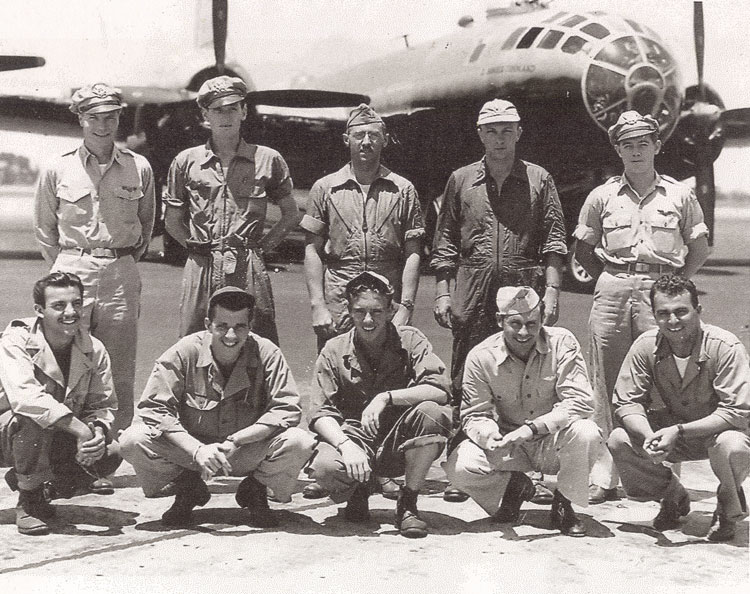 |
| Official USAAF Photo, Courtesy
of Alvin K. Funderburg |
|
The War Against Japan
Ends
When WWII ended in August 1945, Maj Fackler was still in Combat Crew Training at McDill Field. He was identified as an aircraft commander of a select lead crew. His crew had been headed to Okinawa as part of a planned air armada to support the invasion of Japan, scheduled for early 1946. Maj Fackler's crew is shown here in their official picture. This photo came from Alvin K. Funderburg of Dayton, Ohio. Capt Funderburg was Maj Fackler's hand-picked radar operator and is shown standing in the middle of the back row. Maj Fackler is on the far left of the back row. The only other man that Mr Funderburg could positively identify is Lt Dale Richardson, the crew's flight engineer, seen fourth from the left of the back row, next to Funderburg. |
|
Air Weather Service
Post-War Planning
The first Air Weather Service mention of Maj Paul Fackler was when he assumed command of the 59th Reconnaissance Squadron (Very Long Range) Weather on Dec 7th, 1945. The time immediately after the surrender of Japan was one of extreme turmoil for the Army Air Forces. All of the major headquarters had drawn up plans for their post war requirements. AWS wanted two (2) weather reconnaissance groups and eight (8) squadrons equipped with long range B-29s to cover areas without ground based weather stations. What AWS had at war's end was two squadrons. The 53rd was flying B-17G aircraft from three locations stateside, and the 55th, with their B-24s, operating from Harmon Field, Guam. AWS wanted to keep the 55th in place overseas, but were given a very low priority for replacement personnel. So in Jan 1946, the 55th moved to Buckley AAF, CO with two officers and no equipment. Meanwhile, a new squadron was being formed at McDill, AFB. Designated the the 59th RS, (VLR) Weather, it was to be assigned modified B-29s. The prevailing rumor was that the 59th would soon move to the west coast and then later overseas. As previously mentioned, Paul Fackler was named commander of this new unit pending the arrival of the permanent CO. Major Fackler wasted no time. Thousands of officers and enlisted men were assigned to McDill awaiting new military assignments or to be mustered out. More were arriving each day from stateside training bases that were being closed. Major Fackler selected the best he could find from this pool of manpower. The rules about who would be allowed to stay and who would be forced to go home were constantly changing. Several members of Fackler's crew, including Capt Funderburg and Lt Richardson, joined him in the 59th. On 3 Jan 1946, Lt Col Karl T. Rauk arrived at McDill to assume command of the 59th and Maj Fackler became the squadron executive officer. A few weeks later the squadron was alerted to move to Merced Field in California. In Feb 1946, the squadron's approximately 95 officers and 350 enlisted men traveled by train, plane, and automobile to Merced. Upon arrival they went to work. There were no unit aircraft assigned, so the maintenance folks worked on B-29s assigned to other base units, and the aircrew were detached to fly B-29s arriving from the Marianas on to storage facilities while they waited for their own aircraft to be modified and delivered. |
|
Operation CROSSROADS
Nuclear Tests
In Washington, DC, HQ AWS had been closely monitoring the requirements for the planned nuclear tests at Bikini Atoll. Extremely accurate weather forecasts were needed for Operation CROSSROADS. Bombing weather for the Able Day drop, fallout patterns, etc. would all be critical to the Commander of Task Force One. AWS knew they needed a highly skilled weather reconnaissance detachment to support these tests. In Feb 1946, the 59th received the following TWX from their operational headquarters: TWX
RECEIVED THIS DATE FROM HQ CAF DIRECTS THREE B-29 WEA
RCN CREWS BE IMMEDIATELY ORGANIZED TO USE ON CROSSROADS PROJECT WITH
WEA OBSERVERS,
NAVIGATORS, AND RADAR OPERATORS CAPABLE OF MAKING RADAR WIND RUNS AND
TAKING ALL
FORMS OF WEA OBSERVATIONS. REQUEST THIS
HQS BE INFORMED BY TWX IMMEDIATELY IF SHORTAGES EXIST TO PREVENT
ORGANIZATION
OF THIS FLIGHT. ORDERS WILL DESIGNATE
MAJOR FACKLER AS FLIGHT COMMANDER. ALL
POSSIBLE TRNG WILL BE ACCOMPLISHED BEFORE READINESS DATE AT |
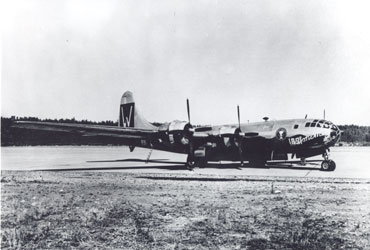 |
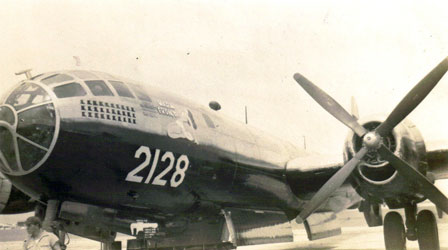 |
| Official
USAAF Photos, courtesy of Air Force Weather History Office |
|
| The two B-29s
identified in the TWX above. Aircraft 44-61891 (left) shows the
"W" painted on the tail, which identified its weather reconnaissance
mission to other aircraft
participating in Operation CROSSROADS. You can also see the CROSSROADS 58th Bomb Wing
logo painted on the forward fuselage.
The aircraft was primarily flown by Lt Frank Bagley's crew and was
named "La Boheme". Aircraft 44-62128 was flown by Lt Alvin Dill's
crew and was named "Warm Front". Seen (right) at Hickam Field on
its return from CROSSROADS. The
thunderstorm symbols show that it
completed 30 weather missions while deployed to
Kwajalein. Note the lack of of gun turrets. This was
part of the weather mission modification, and made the aircraft
lighter. The third aircraft used by Task Unit 1.5.7 was 44-61796. |
|
| After receipt of
the above message, Major Fackler went
to work immediately. He selected 1Lts Frank Bagley, Alvin Dill,
and Shirley Shaw as the pilots for his three crews. The most
experienced men, both aircrew and support, were picked to man "C
Flight". On 10 April 1946, a total of
20 officers and 31 enlisted men departed Merced Field for Hamilton
Field
on their way to Kwajalein Atoll. Once at Kwajalein, C Flight
of the 59th RS (VLR) would be known as Task Unit 1.5.7. This
breaks down
to Task Force One, the overall
Joint Task Force conducting the nuclear test, 1.5 indicates the Army
Air Force Component of the Task Force, and the 1.5.7 identifies the
specific weather reconnaissance element for the test, headed by Maj
Paul Fackler. Under the direction of the Weather Central supporting Task Force One, TU 1.5.7 flew daily missions on tracks designed to optimize the forecasting for the planned tests. During one long mission flown by Lt Dill's crew on 21 Jun, 2Lt Jack Crose, the navigator, wrote a letter to his mother on one of his navigation logs. In the letter he describes life on Kwajalein, and tells of a full scale rehearsal for Able Day that they had flown the previous week. He tells how Maj Fackler had flown on one of the pilotless drone B-17s during the practice. On the actual Able Day, these drones would be directed through the nuclear cloud. Lt Crose said that Maj Fackler really enjoyed the experience. Maj Fackler probably also noted the difficulty the control aircraft had in accurately placing the drone within a target cloud. Perhaps a kernel of an idea was planted that day. |
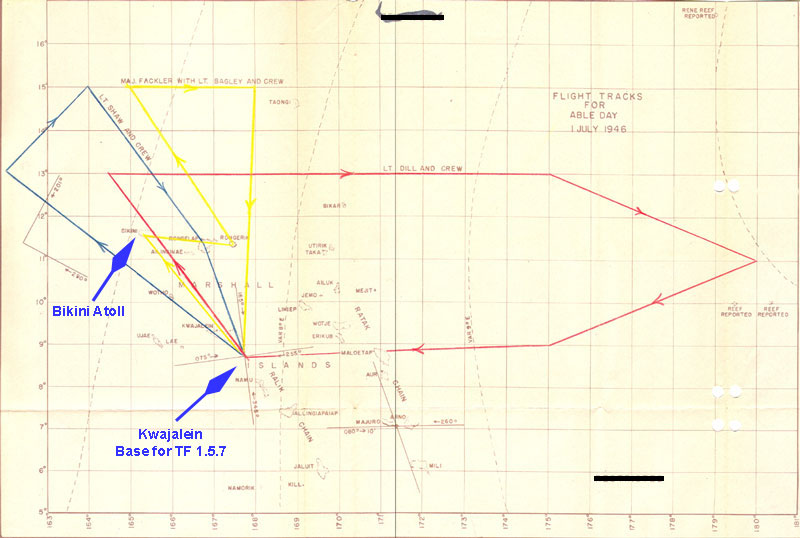 |
| Official USAAF Illustration, Courtesy of
Air Force Weather History Office |
|
Able Shot
Illustration from the 59th RS (VLR) History of 1946. Shows the weather tracks flown by the three crews of TU 1.5.7 on Able Day, 1 July 1946. The actual test involved the dropping of a "Fat Man" type bomb from a B-29 of the 509th Group. This weapon was similar to the one dropped on Nagasaki, Japan, the previous August. Weather was a major factor in the tests. Several delays were based on forecasts of poor bombing weather or of fallout patterns that would endanger test participants and native islanders. |
|
Weather
Reconnaissance Continues to Grow
After a second successful test, Operation CROSSROADS was ended and the men of the TU 1.5.7 happily headed back to Merced. Most were granted leave. Major Fackler submitted his reports to the various headquarters. The weather reconnaissance effort was universally hailed as a success. The Task Force Commander was very pleased with the overall weather support. The Weather Central said that they would have been unable to provide the required forecasts without the daily reconnaissance flights. This success would play heavily over the next few years as the decision was made regarding the future of weather reconnaissance. Paul Fackler had done a great job and everyone associated with the nuclear tests knew who he was. One immediate result of the activities of the 59th was the decision to proceed with the AWS plan to build up the weather reconnaissance force. At that time, the 59th was flying regular Stork tracks from Merced, and they had also assumed the Hawk tracks out of McChord Field, WA, previously flow by B-17Gs of the 53rd. In addition, they continued to plan for a move to Alaska. The 53rd RS made an administrative move to Morrison Field in West Palm Beach, FL, also home of the 1st Weather Reconnaissance Group. Joining the 53rd at Morrison was the brand new 54th, and the 55th, which had been moving around as a "paper" squadron since departing Guam. Major Fackler was selected to command the 55th RS (VLR) at Morrison Field. He took over the squadron on 16 Sep 46. Soon, he was joined by many of the other aircrew from TU 1.5.7, including all three aircraft commanders. An interesting side note to this fact is that the 1947 history of the 55th shows pictures of Lts Bagley, Dill, and Shaw, the aircraft commanders at CROSSROADS, receiving the Army Commendation Ribbon for their participation. Several sources have therefore credited the 55th with having participated in this historic operation. An unofficial history, written by the 55th when they finally disbanded, continues to spread this erroneous story. You, Dear Reader, now know better. The 55th was programmed to move to Fairfield-Suisun after completing training at Morrison Field. They would provide West Coast forecast centers with daily reconnaissance, freeing the 59th to complete their move to Fairbanks, Alaska. |
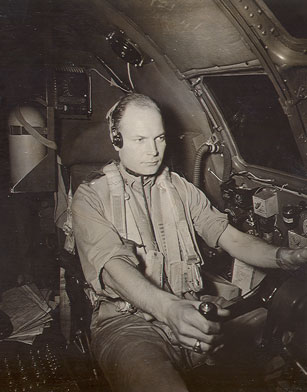 |
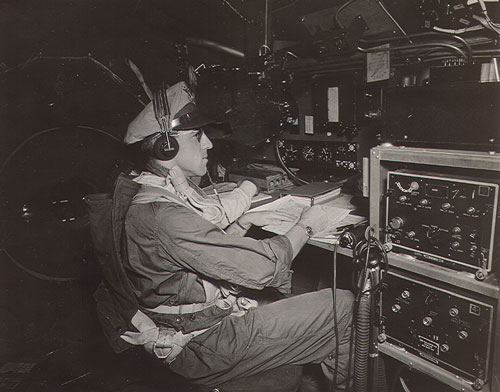 |
| Official USAAF Photos, courtesy of Air Force Weather History Office | |
| Left, Major Paul
Fackler at the controls. Right, Capt Alvin Funderburg works the
radar set. |
|
|
The Unnamed Hurricane - Oct 1946 While getting his squadron trained was Fackler's primary goal, other taskings still had their place. Reports in early October indicated that a hurricane had formed off of Central America and was moving north. Maj Fackler picked a highly qualified crew to conduct a mission for the Hurricane Center on 6 October. He selected Alvin Funderburg, who was the squadron's chief navigator, as radar operator for the flight. A news crew went along, and the mission was written up in Newsweek Magazine. Maj Fackler nursed the B-29 up to 35,000 feet and flew over the hurricane at that altitude. Storm Number 5 was over the western edge of Cuba when they located it. At this point it was between a Category 2 and 3 storm. It would eventually hit the west coast of Florida as a Cat 2 hurricane. Capt Funderburg got several good bird's-eye view radar photos of the eye. These were also used in the magazine. Alvin thinks they were the first radar images really showing a hurricane. While flying south of Cuba, headquarters told them to divert to Guatemala City. This was a challenge, seeing that they did not have any charts for that area. Mr Funderburg recalled drawing a generic chart with the B-29s current position and the coordinates for the Guatemala City airport. They navigated using this coordinate-only chart through skies that were completely undercast. When he thought that they should be over the city, Funderburg told Maj Fackler to start his decent. Funderburg says that a hole appeared in the clouds and there was the airport. Success! |
|
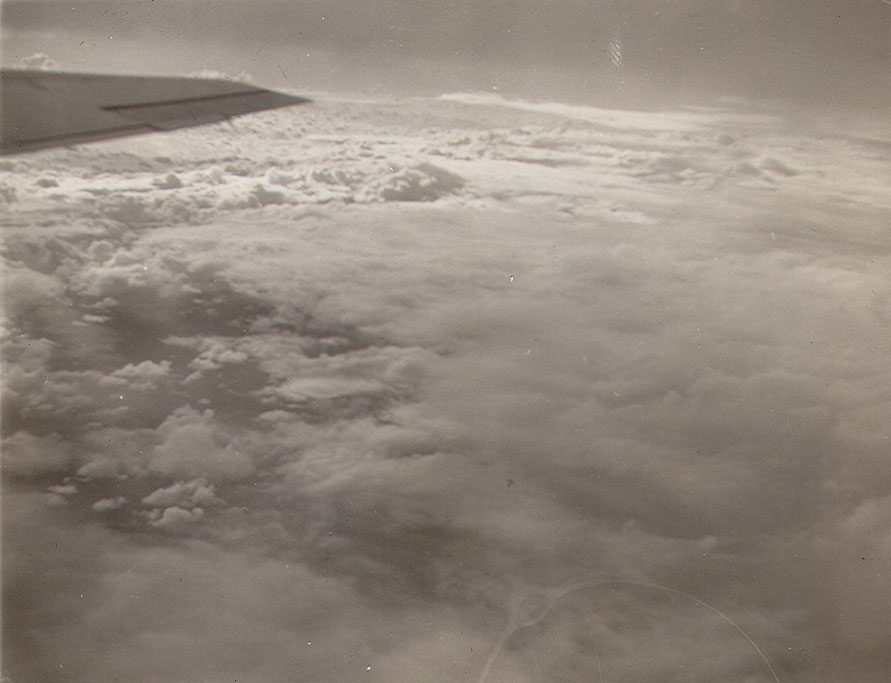 |
| Official USAAF Photo, courtesy of Air Force Weather History Office |
| Photo taken Oct
1946 as Paul Fackler's crew flew over Storm
Number 5 at 35,000
feet. The unnamed hurricane was over the western edge
of Cuba and was estimated to be a Category 2 storm. Taken
from the right scanner bubble showing the buildups far below. |
|
Special Project Ahead
Paul Fackler
continued as commander of the 55th throughout the rest of its
training. In May 1947, after the squadron was certified as ready
to move to Fairfield-Suisun AFB, Maj Fackler
relinquished
command. It is not clear if he was assigned to
the Group or AWS Headquarters. What does appear obvious
is that he was working full time on plans for the next series of
nuclear testing, scheduled for 1948.
High level discussions were taking place in Washington about the various roles and missions for the US Army and brand new US Air Force. One area involved highly classified efforts to establish a national capability to detect a Soviet nuclear test whenever that occurred. One idea was to sample air masses coming out of the Soviet Union and look for radioactive isotopes that would indicate a test had occurred. How could this be accomplished? It was recognized that Air Weather Service was already fielding a weather reconnaissance force that would routinely fly in the areas most likely to yield the desired samples. The decision was made to assign this mission to the USAF, specifically AWS, and to use the Operation SANDSTONE explosions to test whether any of these long range detection programs would work. The Air Material Command was directed to develop an airborne sampling foil for use on the AWS fleet, and to have it ready in time for Operation SANDSTONE. Paul Fackler was front-and-center for these high level talks about atmospheric sampling. In addition to the long range detection question, sampling the various levels in the mushroom cloud would yield much more detailed information about the inner workings and effectiveness of our own nuclear weapons. During the CROSSROADS tests, unmanned B-17 drones had flown through the mushroom cloud shortly after the blasts. This method was again planned for the Sandstone tests. In addition to the B-17 samplers, the Task Force Seven commander would have 8 weather reconnaissance B-29s to provide detailed support to the Task Force Weather Central, and to help track the debris clouds as the moved away from the Pacific Proving Grounds. It was decided that Maj Fackler should again command this element of the test. The weather reconnaissance squadron on Guam would supply the eight aircraft. Welcome to Guam
On 1 Jan 1948, Paul Fackler assumed command of the 514th Reconnaissance Squadron (VLR) Weather at North Field, Guam. The 514th was a "new" weather reconnaissance unit that "replaced" the 54th. In Oct 1947, as part of establishing the Air Force, it was decided to rename the reconnaissance units to honor other WWII bombardment units. The 53rd was renamed the 373rd, the 55th became the 374th, and the 59th became the 375th. In the Pacific, the 54th inactivated in favor of the 514th, and the 512th and 513th names were assigned to Air Weather Service as paper squadrons eventually planned for Japan and Hawaii. The 514th was never authorized any weather reconnaissance related emblem. It appears, however, that Paul Fackler wanted to put his stamp on the squadron, and authorized an unofficial emblem. It depicts a grayish-white thunderstorm on a blue sky. In the foreground is a black bomb with a red or yellow lightning bolt diagonally through it. I have found numerous different 514th aircraft from 1948-49 that display this emblem on the left side of the fuselage. It is also seen in a photograph of the 514th Headquarters building. Capt Roswell L. Crozier, Jr was the 514th Engineering Officer under Maj Fackler. He recalls Fackler directing that the emblem be painted on all 514th B-29s. Operation SANDSTONE -
1948
On 9 Mar 1948, four RB-29s of the 514th departed Guam to join Task Force Seven. Paul Fackler was in the lead aircraft. Once they arrived at Kwajalein, they became Task Unit 7.4.4 (Wea). On 12 Mar, four additional RB-29s arrived. Maj Fackler was the unit commander and Capt Crozier was in charge of the maintenance contingent. These eight crews began flying daily missions in support of the Weather Central, as well as training for the new Top Secret sampling mission. |
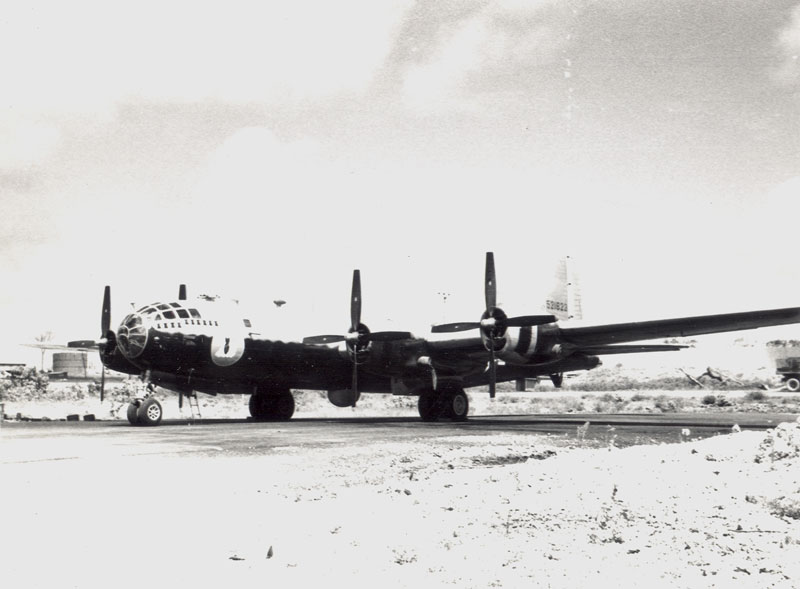 |
| Photo courtesy of the family of Dale Richardson. All rights reserved. No reproduction or other use is authorized. |
| RB-29 45-21823
of Unit 7.4.4 at Kwajalein. This aircraft was flown by Capt
Thomas Welsh and crew. Note the emblem painted on the forward
fuselage and the sampling foil that replaced the aft lower gun turret. |
|
The Bugcatchers Arrive
Air Material Command had been working overtime to have the new air sampling foils ready in time for Operation SANDSTONE. They not only manufactured two different versions (one for combat configured aircraft, and one for aircraft without the gun turrets) but, they also had to provide detailed installation instructions. Then they arranged priority shipping to make sure the foils got to the various field units on time. The new devices went to Kwajalein, Guam, Alaska, California, Bermuda, and Hawaii to meet up with RB-29s that were already deployed. The universal comment from the field units was that installation was the most trouble free that anyone had ever seen. Everyone thought that AMC did a great job. On Kwajalein, Maj Fackler worked his crews hard to be ready for their mission. These crews would be sampling the edges of the visible cloud, as well as attempting to track the cloud as it moved away from the test site. Other units, in far-flung areas of the world, would fly through the projected path of the nuclear debris and attempt to show that Long Range Detection was possible. |
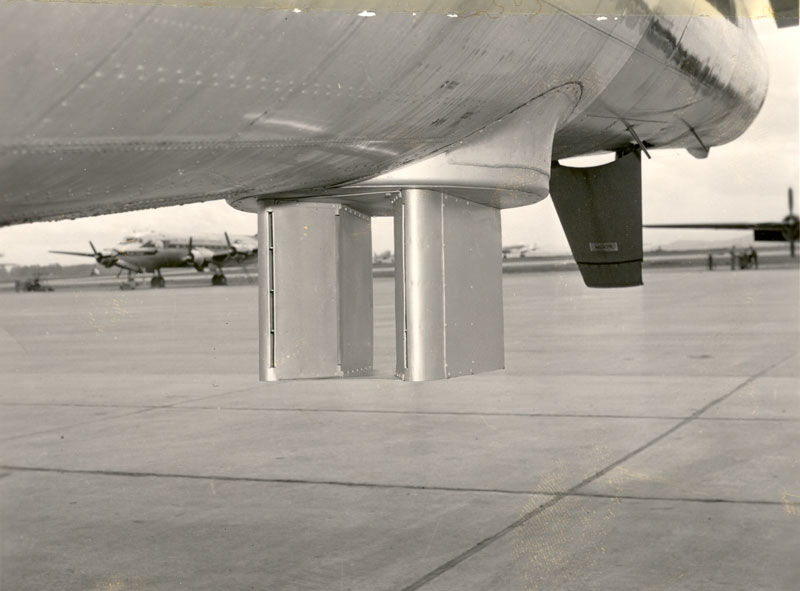 |
| Official USAF Photo, courtesy of Air Force Weather History Office |
| Close-up
of one of the new sampling foils. One of the first things noted
by the
crews
was that it was a very inconvenient location. In order to change
a
filter paper, the aircraft had to be depressurized and a crew member
(usually the radar operator) had to crawl out of the pressurized
section. It
was recommended by everyone that the sampler be moved into the
pressurized
section of the B-29. Within two years, all of the foils had been moved
to the
position formerly occupied by the CFC gunners bubble on top of the B-29
fuselage. |
|
ZEBRA Shot
Operation SANDSTONE consisted of three separate explosions. Shot X-RAY occurred on 14 Apr 1948, Shot YOKE on 30 Apr, and Shot ZEBRA on 14 May. During ZEBRA a pivotal event happened. An RB-29 piloted by Maj Fackler approached the radioactive cloud shortly after detonation. Maj Fackler was making a climbing turn to the left when the aircraft inadvertently penetrated a small finger of the irregular shaped cloud. In a 1963 AFSC Historical Study on the History of Atomic Cloud Sampling, then Colonel Fackler is quoted as saying, "No one keeled over dead, and no one got sick. In fact, there seemed to be no undue alarm among the crew members." The flight continued on for another 40 minutes before the Rad-Safe monitor in the nose of the aircraft recommended that they discontinue sampling and head back to Kwajalein. On the return flight, Fackler flew through several rain showers. The history suggests that this did reduce the external radiation levels on the B-29, but may have also reduced the sample. Upon landing, Fackler discussed the penetration with Col Cody, the assistant Rad-Safe Officer for Operation SANDSTONE. It is obvious that Fackler thought that manned cloud penetrations were possible, perhaps even desirable. I wonder just how inadvertent this penetration was. From all accounts, Paul Fackler was a very good B-29 pilot. I have not heard of too many inadvertent things happening while he was at the controls. Let's just say that he may have been pushing the envelope a bit. ZEBRA Shot marked the end of Operation SANDSTONE. Unit 7.4.4 was released and went back to Guam. Major Fackler stayed on for mission wrap up meetings and then took a well deserved 30 day leave in Hawaii. He continued as Commander of the 514th until May of 1949. Fackler had been selected for promotion to Lt Col, and was transferred to Maxwell AFB to attend Air Command and Staff College. Manned Sampling and
Dedicated Units
After completing ACSC, Lt Col Fackler went to work for the Air Force Special Weapons Command at Kirtland AFB. In 1951, during Operation RANGER, he flew the first intentional penetration of a nuclear cloud by manned aircraft. This was also conducted in a sampling configured B-29. Based on his own experiences, which demonstrated the improvement in positioning a manned sampler vs a drone aircraft within the debris cloud, Col Fackler drew up a plan for a dedicated air sampling unit. He realized that precise sampling was crucial to evaluating the performance of the US nuclear arsenal. Scientists at Los Alamos would later confirm this idea, saying that there was no benefit in testing without robust air sampling to confirm performance of the weapon. Col Fackler's original plan was not approved at that time, mostly because of budget constraints brought on by the ongoing war in Korea. Despite this fact, Maj Gen John Mills, Commander of the Special Weapons Command, asked Col Fackler to go ahead and draw up detailed organizational plan for the command's sampling activities. Gen Mills would continue to press for approval of Col Fackler's plan. In 1952 the AF Special Weapons Command became the AF Special Weapons Center. Soon, Col Fackler's plan was approved by AFSWC, and, in Feb 1953, it was approved by Air Force Headquarters. |
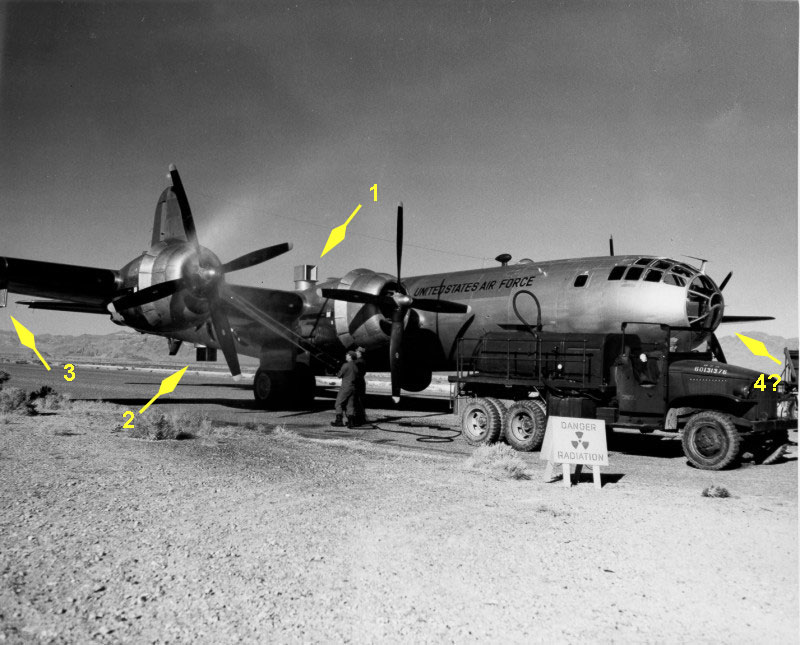 |
| Photo courtesy of National Nuclear Security Administration / Nevada Site Office |
| A B-29 sampler
aircraft used during 1952 and 1953 tests at the Nevada Proving
grounds. There are three sampling foils visible, including one
outboard of # 4 engine (arrow 3). Another photo clearly shows
that this is a foil identical to the lower fuselage sampler.
Making an assumption (which is often dangerous), we can speculate that
there may be a
fourth sampler under the left wing, outboard of # 1 engine.
Arrows were added by the author. This picture was one of several
taken during a demonstration for the press of how an aircraft was made
"safe" after
flight through a radioactive cloud. The two workers are spraying
a solution of Gunk degreaser at # 4 engine. |
|
Bring on the Jets
Col Fackler's plan, as approved, called for 24 officers and 121 airmen equipped with F-84G aircraft to fly through the cloud at various altitudes. The 4926th Test Squadron (Sampling) was activated on 1 April 1953. It soon became apparent to all concerned that the F-84G, even after a program to cut its weight, could not sample at the high altitudes that the scientists wanted. Col Fackler, and others, knew that a replacement was needed. One candidate was the Martin B-57. The B-57 was first used during Operation TEAPOT in 1955. By 1956, the B-57B was a staple of the AFSWC sampling program. In addition to the dedicated men of the 4926th TS, many aircraft and crews were pulled from operational squadrons around the Air Force to help formulate procedures to operate successfully in a nuclear environment, if necessary. These crews received detailed training and were able to go back to their units to train their squadron mates. Col Fackler was a mainstay of this program, both at Kirtland, and at the 1009th Special Weapons Squadron in Washington, DC, until his retirement. Coming full circle, the Air Weather Service was made executive agent for all USAF sampling in 1961. The 4926th became part of AWS at that time. |
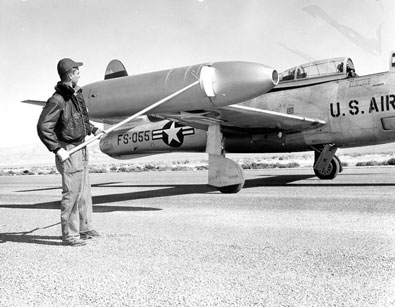 |
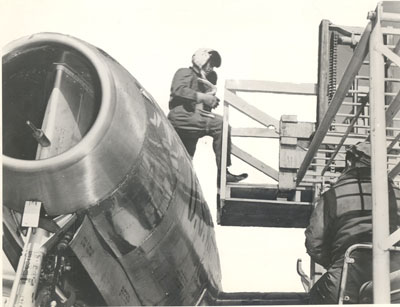 |
| Photos courtesy of National Nuclear Security Administration / Nevada Site Office | |
| The photo at left
shows a technician removing a sampling filter after flight. The
picture at right shows a method to allow the pilot to exit a "hot"
aircraft without touching the exterior surface. A specially
modified forklift brought the platform close enough for the pilot to
step off. |
|
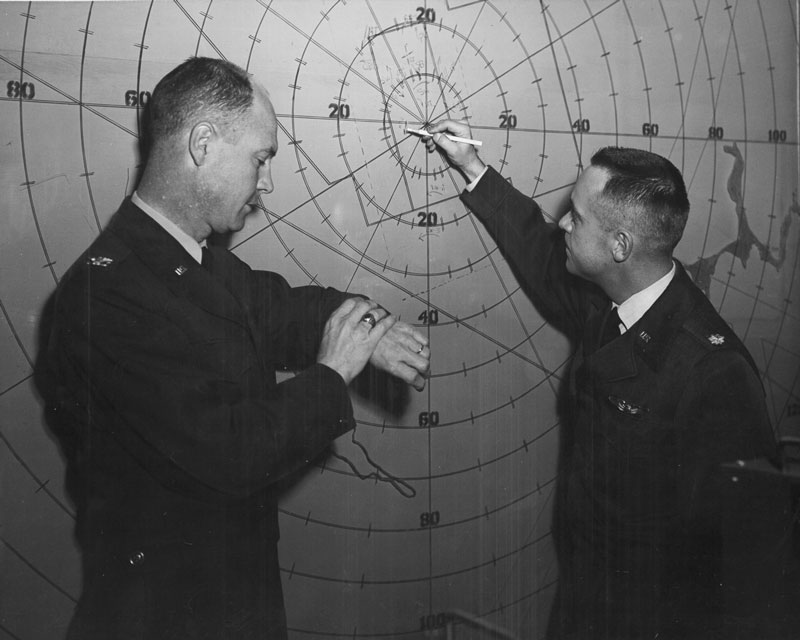 |
| Photo courtesy of National Nuclear Security Administration / Nevada Site Office |
| Col Fackler, the
Test Air Operations Officer, (left)
checking the time to planned detonation. Maj De Vries (right)
plots the location of all the aircraft participating in the test. |
|
Final Thoughts
I am tremendously impressed by the accomplishments of Paul Fackler and the many contributions he made to weather reconnaissance and atmospheric sampling. No one ever wanted to see nuclear weapons used in anger, but we absolutely needed to learn as much as possible about their performance and dangers. Let's remember that the scientists of the Manhattan project were very surprised by the medical issues that arose in Japan after the attacks on Hiroshima and Nagasaki. How much and what type of radiation the body can "safely" absorb is still very much up for debate. The crews who participated in these sampling flights were closely monitored, well, as close as the basic dosimeter and film badge allowed. Many veterans of the domestic nuclear sampling program, and the long range detection efforts, have subsequently been diagnosed with cancers that appear to be related to radiation exposure. Why do some succumb and others, who received much higher doses, show no adverse signs? Personally, as a non-medical expert, I think it has a lot to do with genetics and maybe some luck. As a public policy, I wish we had accepted every radiation-related cancer claim by these veterans as valid, and provided the appropriate VA-funded care. Instead, the "system" made the veteran prove he had excessive exposure, and then fought tooth-and-nail to deny benefits. In the long run this has cost us more dollars and left the veterans feeling abandoned. Paul Fackler died in 1986 at 71 years old. He suffered a type of brain cancer that can be triggered by radiation exposure. There is no proof that it was caused by his many sampling flights through nuclear clouds. There is also no proof that it wasn't. His widow and sons, as well as this author, will always wonder. There is no doubt that Paul Fackler was one hell of a B-29 pilot, leader of men, and patriot. Thank you, Colonel, for all you did. Rest in peace. |
Go to Top of Page
Questions or comments, write to the web master at: awra038@aol.com
|
Acknowledgements
Numerous sources were used in the writing of this article about Paul Fackler and his contributions to weather reconnaissance and atmospheric sampling. Primary among these were Air Weather Service unit histories that are maintained by the Air Force Weather History Office at Offutt AFB, NE. Other resources used, in no special order: Phone interviews, by the Author, with Paul Fackler's sons, Paul and Mike, in 2006. Interviews, letters, and documents from Jack and Nadine Crose. 2006 interviews with Alvin Funderburg and Roswell Crozier. These gentleman both knew Colonel Fackler well, and provided invaluable assistance. Spying without Spies by Charles Ziegler and Dr David Jacobson. This is a tremendous book that gives the reader a look at the politics and science leading to establishment of a Long Range Detection capability. A great read. The Fireballs by Robert A. Mann. Self-published history of the 54th and 514th from 1947 to 1954. Air Weather Service, Our Heritage, 1937-1987 by Marcus, Halbeisen, and Fuller The online archives of the 1994 President's Advisory Committee on Human Radiation Experiments (ACHRE) maintained by George Washington University (http://www.gwu.edu/~nsarchiv/radiation/) The online photo library of the National Nuclear Security Agency, part of the Department of Energy. (http://www.nv.doe.gov/library/photos/complete.aspx) Colonel Fackler's Official Biography, provided by the Air Force Research Laboratory at Kirtland AFB, NM. Many thanks to Mr Stephen Watson, Archivist. |